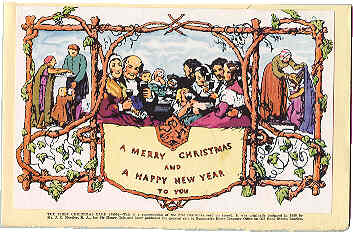
The first Christmas Card
Sir Henry Cole first thought up the idea for the first Christmas card in 1843. He could scarcely have imagined into what an enormous industry his idea would grow. Nowadays, the British Post Office handles over six hundred million Christmas cards a year. The advice to “Post early for Christmas” first went out from the Post Office in 1880.
Sir Henry Cole asked his friend John Callcott Horsley, a fashionable artist, to design the first Christmas card. Horsley’s signature at the bottom corner, together with a little caricature of himself. One thousand cards were printed, but they did not sell very well and Sir Henry decided not to repeat the idea next year.
Cole was the first director of that great London museum, the Victoria and Albert in South Kensington. He was an energetic man, particularly interested in improving the public’s taste, and educating them about art. His Christmas cards were sold in a shop he organized in Bond Street called Felix Summerley’s Treasure House. Here children’s books with good-quality illustrations were sold, and probably the first ever ‘Colour Box for Little Painters’ with the ‘ten best colours’, brushes, and hints on how to use it all.
Some people criticized the Cole and Horsley’s card because it showed a scene of hearty eating and drinking. Encouraging drunkenness! In fact, Horsley was a very conventional soul; later, because he insisted that artists should not use nude models for their paintings, he was nicknamed Clothes-Horsley.
Cole’s card was hand coloured, artistic and expensive: in 1843 it cost one shilling. Twenty years later the first mass-produced commercial Christmas cards came on the market. They were brightly coloured and cheap; newly developed printing techniques made this possible. The idea of sending Christmas cards really caught on. More of the British public could now read and write. And Sir Rowland Hill’s postal reform of 1840 meant it only cost a penny to send one of the new cards, in an envelope, anywhere in the British Isles. Before the reform it cost fourpence to send one sheet of paper fifteen miles, sixpence to send it thirty miles, and an envelope counted as an extra sheet. Letters were usually paid for on delivery, so the postman’s visit was not welcome. Now, in the 1860s and 70s, in the middle of Queen Victoria’s reign, people began to enjoy sending and receiving Christmas cards. The cards were elaborate and very sentimental, with pictures of cupids, snowy stage-coaches, and little children. They had paper lace stuck around the edges, ribbons, pieces of velvet and glitter. Children and young ladies collected the prettiest Christmas cards and put them into albums to keep alongside mottoes and valentines.
Perhaps the Christmas card grew out of the tradition people in many different countries have had for centuries, a tradition that goes back to the ancient Egyptians and Romans, of exchanging little tokens of friendship at the New Year.





You must be logged in to post a comment.